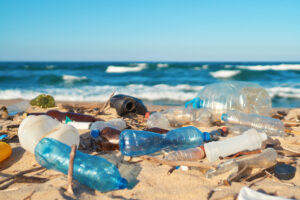Pollution in Oceans Is Leading to Plastic in Your Body

If you think plastic pollution is a problem only on roadsides and beaches, consider the old adage “What goes around, comes around.”
A recent study found that sea salt around the world has been tainted by plastic. These particles have been identified in sea salt in China, France, Spain, the U.K. and the U.S.
Other studies have found high plastic levels in shellfish, beer and water – both bottled and from taps.
That’s a big concern. It means microplastics are now in the human food chain.
The average American could be swallowing more than 660 pieces of microplastic annually from sea salt. And the 90% of Americans who use too much salt to begin with are probably ingesting even more.
And this problem could get even worse.
Every year, about 12.7 million tons of plastic find their way into oceans around the world. That’s like dumping a garbage truck full of plastic into the sea every minute.
And by 2050, all the plastic in the oceans will weigh more than all the fish in them.
To give you an idea of just how much plastic we’re dealing with, this is a picture of Kuta Beach as seen from Bali’s Badung Regency Resort.

Beautiful, pristine and inviting.
But there’s another view of that same beach that the Badong Regency doesn’t want you to see. Here’s a picture of the same beach from a different angle taken just two years ago.

You won’t see this view in any Bali travel brochure.
Sadly, this polluted shoreline isn’t unique to Bali. Beaches in some of the most remote areas of the world are being inundated with plastic waste.
The world’s oceans have become superhighways for all kinds of plastic debris. Every country with a shoreline has an exit ramp for plastic leading to its beaches.
And once it’s there, it’s everyone’s problem.
Plastic in Our Oceans
How does all of this plastic get into the ocean?
My first thought was drunken cruise ship revelers throwing water bottles overboard. But that’s not the case.
Monsoons, floods and other high-water events sweep discarded plastic waste into the world’s rivers. It’s estimated that the 2011 Tōhoku earthquake and resulting tsunami were responsible for up to half of all the plastic.
From there, it’s all downhill to the ocean. Much of that river-borne plastic eventually ends up on a beach somewhere.
That’s when rocks, sand, sun and wave action break it down into tiny pieces. Some of these pieces are so small they are actually suspended in the water.
They can be viewed only with a microscope. That’s when plastic’s contained toxins have a greater chance of leaching into the environment.
Some of it ends up in huge, floating “garbage islands.” The Great Pacific Garbage Patch (GPGP) covers more than 617,000 square miles.
That’s twice the size of Texas. The GPGP contains an estimated 1.8 trillion pieces of plastic, weighing 80,000 tons.
Sure, it’s in the middle of the ocean. So it’s really not harming anything, right?
Wrong. Consider the lonely albatross. It’s a seabird that often stays away from land for years at a time.
Autopsies of dead albatrosses reveal stomachs full of bottle caps and other plastic waste. Fish autopsies present a similar picture.
Many of the world’s ocean creatures often mistake small pieces of plastic waste for food. Plastic pollution in the ocean is a slow-moving shipwreck.
What’s in This Mess for Investors?
Plenty. Tighter restrictions on single-use plastics, which make up 40% of all plastic production, are right around the corner.
The European Union is banning them starting next year. That’s good news for aluminum can maker Ball Corporation (NYSE: BLL).
About 70% of all aluminum produced comes from recycled stock. Increasing bans on plastic will boost its business.
Big waste haulers like Waste Management (NYSE: WM), Republic Services (NYSE: RSG) and Waste Connections (NYSE: WCN) could also benefit as governments enact more stringent recycling laws.
It’s disheartening to see the growing plastic pollution crisis. Some scientists believe it’s as serious a risk to the planet as global warming is.
Environmentally conscious investors might want to consider investing in the recycling sector as the world begins to tackle this issue.
EVs… renewable energy… new technology… cutting-edge biotech… online learning… these are the areas my colleague Matthew Carr and I are investing in. And you should be too.
Good investing,
Dave






